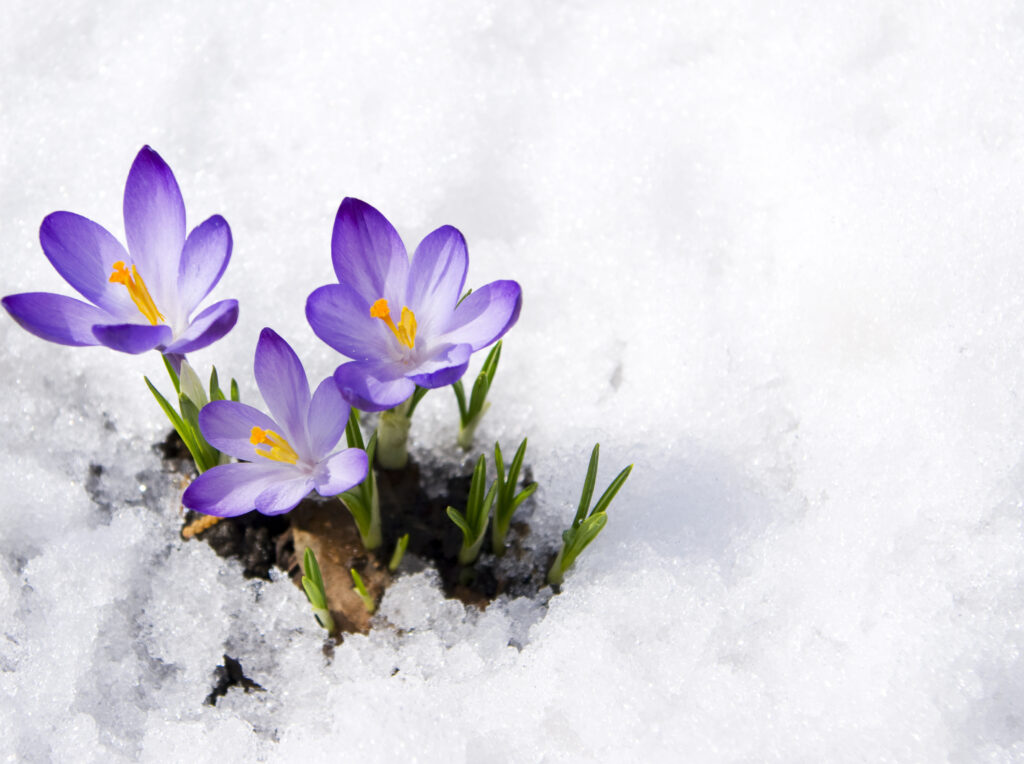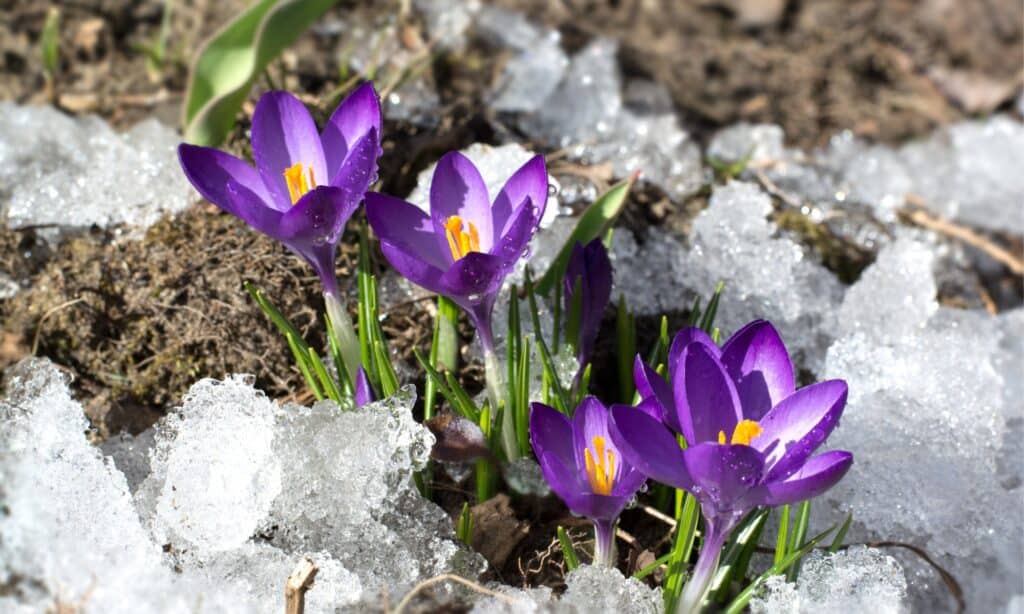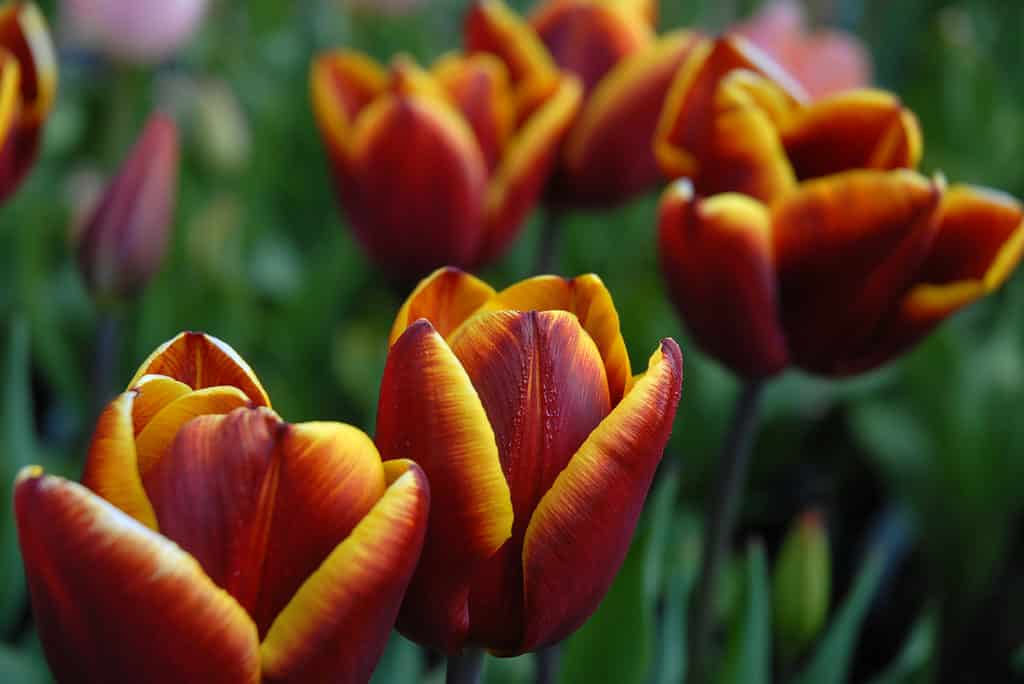There are many popular springtime flowers that help folks recognize a new season upon us. The crocus, for example, is one of the first to pop its head up in springtime. It often blooms when there is still snow on the ground. The tulip, on the other hand, is associated with a mid-to late-spring holiday, Easter, which may help others fully embrace the season’s arrival. Whatever your idea of spring, though, these stunning flowers are here to let you know the season has changed. They aren’t particularly similar, though, so you may want to investigate a little to learn how well-suited they may be to your gardening plans.

Crocuses in snow are a common sight in certain parts of the world.
©Volkova Irina/Shutterstock.com
| Tulip | Crocus | |
|---|---|---|
| Classification | Tulipa, over 110 species, thousands of hybrids and cultivars | Crocus; approximately 100 species in the genus |
| Description | Tulips come in a wide range of colors including nearly any shade you can think of save true blue. The plants have 2 to 3 leaves that cluster at the base and the flowers may come in a range of patterns and forms. | Crocus plants come in various shades of white, purple, and yellow flowers, with no visible lower stem and bifacial green leaves. |
| Uses | Tulips are used for many things, ranging from culinary uses replacing onions in cooked or raw dishes, in home gardens, cutting gardens, and commercial gardens, as well as given as gifts and planted at tulip festival locales. | Crocuses are early spring bloomers that help provide food for pollinators early in the season, as well as serving as ground cover and ornamental gardening. The plant is also the source of the spice saffron. |
| Origins and growing preferences | Tulips originated in Central Asia near the Russian-Chinese border but is more well-known for being the symbol of the Ottoman Empire in the 10th Century and, of course, as being a wildly popular export of Holland. The plant requires full sun, well-draining soil, and protection against moles and mice underground. | Crocuses date back to as early as the days of King Solomon of the Old Testament in the Bible. The flowering plant thrives in full sun, in fertile, light alkaline soil, and in well-draining soil with bone meal. |
| Unique facts and features | Tulips have been popular enough to crash stock markets and become the symbol of empires, while also inspiring many artworks across the world, and being “colored” by a virus. | Crocuses are the source of the popular spice, saffron, but it takes about 4000 stamens to make 1 ounce of the highly coveted flavoring agent. The plant grows around the world in many environments, largely thanks to the Dutch cultivating the plant and helping it spread across the planet. |
Key Differences Between Tulip and Crocus
Tulips and crocuses are beautiful springtime flowers that for many folks around the world signal springtime. The two plants, however, belong to very different plant families, bloom at different times, and are used for different things altogether. The differences between the two plants are significant and may help you determine which plant is more appropriate for your gardening needs.
Tulip vs. Crocus: Classification

Elegant Lady tulips are an example of a beautiful variety of variegated tulip.
©Sergey V Kalyakin/Shutterstock.com
Tulips, or Tulipa as they are known botanically, belong to the lily (Liliaceae) family. They are bulbous in nature (meaning they grow from bulbs) and produce showy, bell-shaped flowers in a range of colors. They may be grown in nearly any environment, save tropical environments, as they require a cold weather dormancy season.
Crocus are a genus of seasonal flowering plants that belong to the iris or Iridaceae family. There are about 100 species belonging to the genus, resulting in a range of looks and forms among the plants that may grow in shades of white, purple, or yellow. They grow from corms (which are similar to bulbs) and are low-ground plants with no visible lower stems.
Tulip vs. Crocus: Description

Crocuses can be planted in the fall for beautiful blooms in late winter. And yes, they really will pop up through the snow.
©iStock.com/Olga U
Tulips come in a huge array of colors, including red, white, pink, cream, apricot, orange, green, golden yellow, mauve, deep burgundy, almost black, and violet, as well as many others, save true blue shades. The plant grows bell-shaped flowers and has clusters of two to three leaves that form at the base of the plant. They may come in solid colors or broken forms, meaning striped or vaguely patterned shades and colors.
Crocuses come in many shades of yellow, white, or purple, ranging from deep purple to lilac purple, pale white to bright white, and vivid yellow to milder, creamy shades of yellow. The plants have 3 stamens in each flower and are acaulescent, meaning they lack a visible lower stem (making them great low-ground cover plants). They grow bifacial green leaves and multiple flowers per plant.
Tulip vs. Crocus: Uses

Purple pride tulips are a beautiful solid shade of pink-purple.
©Alex Manders/Shutterstock.com
Tulips have been used for a variety of purposes as long as they’ve been cultivated by humans. Many of us would recognize them as springtime blooms celebrated at tulip festivals the world over, in floral arrangements, and, of course as some of the first blooms of spring. They are also often used in wedding arrangements and décor, as the inspiration and elements of many artworks in many mediums, in boutonnieres and corsages, and as gifts. They are also edible and are used in the culinary world in both cooked and raw forms, often replacing onions in various dishes. The plant is also frequently used in skincare products as tulips are known to sooth dry skin and to help heal minor skin wounds, calm insect bites and stings, and similar minor ailments.
The crocus is another early spring bloom, often popping up through the snow as the very first flower of the season. They are used as partial ground cover, as potted plants on occasion, and generally as an ornamental garden flower. Nearly all parts of the plant are toxic. However, some of the plant is used for various kinds of medicinal purposes. The plant has been used by experts to help treat rheumatoid arthritis, gout, and something known as familial Mediterranean fever.
The one part of the plant that is used in the culinary world is the stamens of the crocus, which are the threads that we commonly know as saffron. The saffron spice is used in a wide range of culinary dishes, including many Middle Eastern and Asian dishes, as well as Mediterranean foods. Saffron has also been used in the perfumery industry, in essential oils and bath oils, even in incense and soaps. It is also a food coloring agent and a natural yellow dye for clothing and fabrics.
Warning: Never use crocuses or other toxic plants to treat any kind of ailment. Only work with medical care professionals with extensive knowledge of toxicology and herbal or holistic medications and follow instructions precisely.
Tulip vs. Crocus: Origins and Growing Preferences

Abu Hassan Triumph tulip is a unique color and form of tulip.
©Josie Elias/Shutterstock.com
The tulip plant has a rather intriguing historical line. It dates back to before the Ottoman Empire and came into prominence in the 10th Century in Persia (modern-day Iran). The flower was so well-loved and represented the ruling class so well that it became the Empire’s symbol at that time. In the mid-1500s, a Viennese ambassador to Turkey, Augier Ghislain de Busbecq, brought word of the plant and eventually sent seeds to his homeland from Constantinople in 1562. The bulbs made their way into the hands of bulb grower and developer Carolus Clusius. He was credited with the spread of other bulbs for spring blooms, like irises and hyacinths. When the tulips appeared in his garden, folks knew there was something incredible there. In fact, the tulips became so exciting that they were stolen from Clusius’ bulb garden. The broken flowers (striped tulips) that were stolen birthed the tulip industry in modern times.
To grow your own tulip bulbs as happy, healthy plants, you’ll want to plant them 6 to 8 inches deep, with the pointed end up, in well-draining, loose soil. They should be 4 to 6 inches apart. Make sure they are located where they’ll get full sun and proper watering (i.e., won’t be drowned by precipitation) and protected against mice and moles who like to dig for and nosh on the bulbs.
The crocus is another ancient flower that dates far back in history, with early appearances in famous writings like the Song of Solomon in the Old Testament of the Bible. The versatile bulbs originated in parts of Asia and the Mediterranean where you’ll still see them flourishing. They were cultivated for their beauty, but even more for the saffron made from their stamens. The flowering plants were spread throughout much of the Roman Empire, including into Britain, and by 1330 they were used for herbs, seasoning, flowering plants, and clothing and hair dyes, thanks to those saffron threads. Crocuses were among some of the first bulbs to be transported to Noth America by settlers.
The beautiful flowers require alkaline soil that is both fertile and light, and good, strong sunlight exposure without scorching. They may handle a little shade, particularly in warmer climates and weather, but won’t bloom as vividly and prolifically. They need well-drained soil and should be planted in groups, about 3 inches or less apart, between 5 and 7 inches deep, with bone meal mixed into their soil.
Tulip vs. Crocus: Special Features and Fun Facts

The beautiful tulip grows in a huge range of regions and climates. However, certain varieties are better suited to some regions than others.
©MBL1/Shutterstock.com
Both tulips and crocuses have long, storied, and intriguing histories, many unique facts about them, and qualities and features that might take you by surprise. Just a few of these things include the following fun facts.
- Tulips have been incredibly popular since their modern European cultivation in the late 1500s to early 1600s. Did you know, though, that there was an actual period of four years known as Tulip Mania? During this time, tulips were so wildly popular that sellers held them back thinking they could sell them for a massive profit later on. The problem was, though, that they all held them back until about the same time as each and wound up flooding the market instead. This resulted in one of the best-remembered market crashes in modern history.
- The crocus plant most of us know is thought of as small, bright, and purple. However, some of the plants may actually reach 12 inches in height and may be purple, yellow, white, or mauve.
- The tulip has been popular in modern history. As noted above, but it was also extremely well-beloved long before Europeans knew of the plant. Way back during the Ottoman Empire, they were so loved already that they were the Empire’s symbol. Because of this and the continued desirability of the flowers, they have been long featured in some of the world’s greatest artworks, including ancient Islamic pieces, German works by Jacob Marrel, and, of course, many by the Dutch Old Masters.
- Crocuses natively bloom in a range of places like rocky mountainsides, woodlands, and scrublands. You’ll find them near ancient ruins, like those found on Aegina Island, Greece, cemeteries, and many other places related to remembering the gone.
- Tulips are technically wildflowers in central Asia in the Tien Shan Mountains near the Russian-Chinese border.
- The crocus is actually a member of the iris family. There are around 80 species providing us with a wide range of uniquely nuanced plants growing all over the world.
- Tulips are known for their vivacious colors and unique color forms. The stripes on many, however, aren’t a naturally occurring quality, but rather something created by a virus carried by aphids. This wasn’t known until 1931 when scientists realized this. Now, of course, we still have striped tulips, but they’re formed this way through artificial means by using DNA of the virus without the works of the aphids.
- If you love saffron you might think of growing your own crocuses at home to cultivate for your own seasoning threads. However, you’re going to need a heck of a lot of flowers because it takes about 4,000 dried stamens from crocus to make a single ounce of the popular herb.
- Most of us know that tulips are sun lovers. But did you know that they’ll follow the sun while alive and even after they’ve been cut and put in a vase? Move them around the house at different times of day to make those cut flowers happy and fresh longer.
- The Dutch aren’t just known for cultivating tulips. They also began cultivating crocuses in the 1600s and created many varieties and cultivars for use in Britain during the Elizabethan era.
- Holland remains the largest producer of tulip bulbs in the world, and exports about 3 billion bulbs every single year.
- Crocuses have been around a crazy long time, with the first references dating back to the Bronze Age, as well as Ancient Egypt. The flowering plant is mentioned in many historical pieces including the Bible, specifically in the Song of Solomon. And back then, the plant wasn’t just used for flowers, either. Women used saffron for hair and clothing dye and the corms of the flowering plants were actually used as currency.
The photo featured at the top of this post is ©
Thank you for reading! Have some feedback for us? Contact the AZ Animals editorial team.






